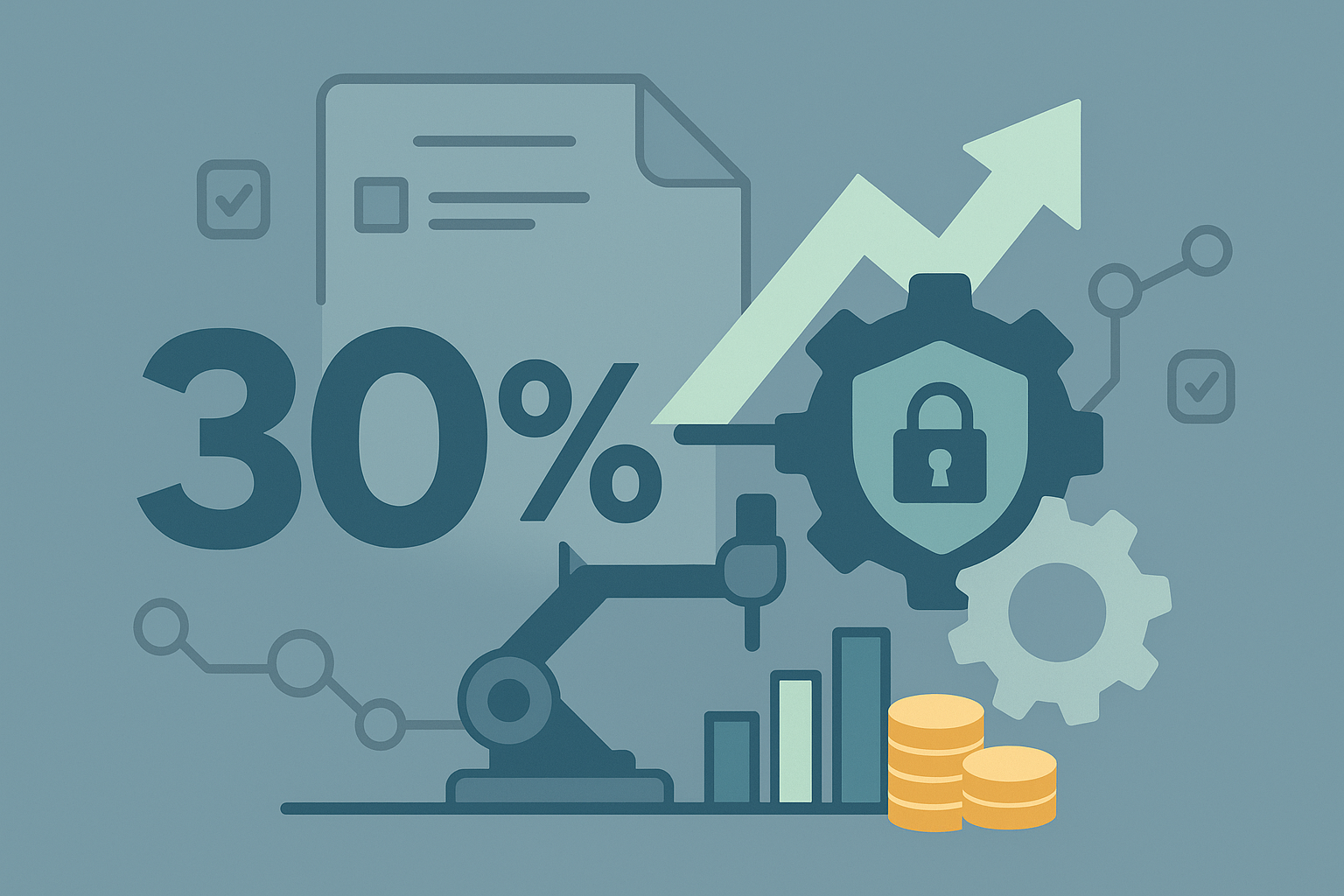E-Commerce Inventory automatisieren: KI-Lagerverwaltung für Online-Händler
DSGVO-konforme Inventory-Automatisierung für deutsche E-Commerce. Bestandsplanung, Auto-Nachbestellung und Multi-Channel-Sync für höhere Profitabilität.

Inventory-Management-Automatisierung für deutsche E-Commerce
Effizientes Inventory Management ist für deutsche E-Commerce-Unternehmen überlebenswichtig. Intelligente Automatisierung kann dabei helfen, Lagerkosten zu reduzieren, Stockouts zu vermeiden und die Kundenzufriedenheit zu steigern.
Entdecken Sie unsere E-Commerce Automatisierungslösungen oder berechnen Sie Ihr Einsparpotenzial mit unserem ROI-Rechner.
Die Herausforderungen des deutschen E-Commerce
Besonderheiten des deutschen Markts
Regulatorische Anforderungen:
- Gewährleistungsrecht: 24 Monate Gewährleistung
- Widerrufsrecht: 14 Tage Online-Rückgaberecht
- Verpackungsverordnung: Umweltgerechte Verpackung erforderlich
- DSGVO: Datenschutz bei Kundendaten und Analytics
Marktcharakteristika:
- Hohe Qualitätserwartungen der deutschen Kunden
- Preissensitivität und Vergleichskultur
- Schnelle Lieferzeiten als Wettbewerbsfaktor
- Multi-Channel-Vertrieb (Online, Marktplätze, stationär)
- Saisonale Schwankungen (Weihnachten, Sommerschlussverkauf)
Warum Automatisierung kritisch ist
Operative Herausforderungen:
- Komplexe Bestandsplanung bei saisonalen Schwankungen
- Multi-Channel-Synchronisation zwischen verschiedenen Verkaufskanälen
- Supplier-Management mit verschiedenen Lieferanten
- Kostenoptimierung bei steigenden Lagerkosten
- Compliance mit deutschen und EU-Vorschriften
Framework für Inventory-Management-Automatisierung
1. Intelligente Bestandsplanung und Forecasting
KI-basierte Nachfrageprognose:
// Demand Forecasting Engine
const demandForecastingEngine = {
dataInputs: {
historical_sales: 'last_24_months',
seasonal_patterns: 'identify_cyclical_trends',
market_trends: 'google_trends_integration',
competitor_analysis: 'price_and_availability_monitoring',
external_factors: 'weather_events_holidays_promotions'
},
algorithms: {
time_series: 'ARIMA_SARIMA_models',
machine_learning: 'random_forest_neural_networks',
ensemble_methods: 'weighted_combination_multiple_models',
anomaly_detection: 'identify_outliers_and_exceptions'
},
outputs: {
daily_forecast: 'next_90_days',
weekly_forecast: 'next_52_weeks',
monthly_forecast: 'next_12_months',
confidence_intervals: 'upper_lower_bounds',
risk_assessment: 'stockout_overstock_probability'
}
}
// Implementierung eines einfachen Forecasting-Algorithmus
const calculateDemandForecast = async (productId, timeframe) => {
// Historische Verkaufsdaten abrufen
const historicalSales = await getSalesHistory(productId, '24_months')
// Saisonale Muster identifizieren
const seasonalFactors = identifySeasonalPatterns(historicalSales)
// Trend-Analyse
const trendAnalysis = calculateTrend(historicalSales)
// Externe Faktoren berücksichtigen
const externalFactors = await getExternalFactors(timeframe)
// Prognosemultiplikatoren berechnen
const forecastMultipliers = {
seasonal: seasonalFactors[timeframe.month],
trend: trendAnalysis.slope,
external: externalFactors.impact,
market: await getMarketGrowthRate(productId)
}
// Baseline-Nachfrage ermitteln
const baselineDemand = calculateBaselineDemand(historicalSales)
// Finale Prognose
const forecast = baselineDemand *
forecastMultipliers.seasonal *
forecastMultipliers.trend *
forecastMultipliers.external *
forecastMultipliers.market
return {
predicted_demand: Math.round(forecast),
confidence_score: calculateConfidence(historicalSales, forecast),
risk_factors: identifyRiskFactors(externalFactors),
recommendations: generateRecommendations(forecast, currentStock)
}
}
2. Multi-Channel-Bestandssynchronisation
Real-time Inventory Sync:
graph TD
A[Central Inventory System] --> B[Real-time Sync Engine]
B --> C[Shopify Store]
B --> D[Amazon Marketplace]
B --> E[eBay Store]
B --> F[Otto Marketplace]
B --> G[Zalando Partner]
B --> H[Google Shopping]
C --> I[Order Processing]
D --> I
E --> I
F --> I
G --> I
H --> I
I --> J[Inventory Update]
J --> B
subgraph "Error Handling"
K[Stock Discrepancy Detection]
L[Automatic Correction]
M[Manual Review Queue]
end
Intelligent Channel Allocation:
// Multi-Channel Inventory Allocation
const optimizeChannelAllocation = async (productId, availableStock) => {
// Channel-Performance-Daten sammeln
const channelPerformance = await getChannelMetrics(productId)
const channels = {
own_shop: {
performance: channelPerformance.own_shop,
margin: 0.4, // 40% Marge
velocity: channelPerformance.own_shop.sales_velocity,
strategic_importance: 1.0 // Höchste Priorität
},
amazon: {
performance: channelPerformance.amazon,
margin: 0.15, // 15% Marge (nach Amazon-Gebühren)
velocity: channelPerformance.amazon.sales_velocity,
strategic_importance: 0.8
},
ebay: {
performance: channelPerformance.ebay,
margin: 0.25, // 25% Marge
velocity: channelPerformance.ebay.sales_velocity,
strategic_importance: 0.6
},
zalando: {
performance: channelPerformance.zalando,
margin: 0.12, // 12% Marge
velocity: channelPerformance.zalando.sales_velocity,
strategic_importance: 0.7 // Fashion-relevant
}
}
// Allocation-Score berechnen
const allocationScores = {}
for (const [channel, data] of Object.entries(channels)) {
allocationScores[channel] =
data.margin * 0.3 +
data.velocity * 0.4 +
data.strategic_importance * 0.3
}
// Bestand proportional zuteilen
const totalScore = Object.values(allocationScores).reduce((a, b) => a + b, 0)
const allocation = {}
for (const [channel, score] of Object.entries(allocationScores)) {
allocation[channel] = Math.floor(availableStock * (score / totalScore))
}
// Safety Stock für Prime Channel (eigener Shop)
const safetyStock = Math.floor(availableStock * 0.2)
allocation.own_shop += safetyStock
return allocation
}
3. Automatisierte Nachbestellung (Auto-Replenishment)
Intelligente Bestellauslösung:
// Smart Replenishment System
const autoReplenishmentEngine = {
triggers: {
stock_level: 'reorder_point_reached',
demand_forecast: 'predicted_stockout_within_lead_time',
seasonal_preparation: 'advance_ordering_for_peak_seasons',
supplier_terms: 'optimal_order_quantity_for_discounts'
},
calculations: {
reorder_point: (averageDemand, leadTime, safetyStock) => {
return (averageDemand * leadTime) + safetyStock
},
economic_order_quantity: (annualDemand, orderingCost, holdingCost) => {
return Math.sqrt((2 * annualDemand * orderingCost) / holdingCost)
},
safety_stock: (maxDemand, avgDemand, maxLeadTime, avgLeadTime) => {
return (maxDemand * maxLeadTime) - (avgDemand * avgLeadTime)
}
}
}
// Automatische Bestellentscheidung
const evaluateReplenishmentNeed = async (productId) => {
const product = await getProductData(productId)
const currentStock = product.current_stock
const supplier = product.supplier
// Aktuelle Nachfrage und Lead Time
const demandData = await getDemandMetrics(productId)
const supplierData = await getSupplierMetrics(supplier.id)
// Bestandsmetriken berechnen
const metrics = {
reorder_point: autoReplenishmentEngine.calculations.reorder_point(
demandData.average_daily_demand,
supplierData.average_lead_time_days,
product.safety_stock
),
economic_order_quantity: autoReplenishmentEngine.calculations.economic_order_quantity(
demandData.annual_demand,
supplier.ordering_cost,
product.holding_cost_per_unit
),
days_of_stock: currentStock / demandData.average_daily_demand
}
// Entscheidungslogik
const decision = {
should_reorder: currentStock <= metrics.reorder_point,
quantity_to_order: metrics.economic_order_quantity,
urgency: currentStock <= (demandData.average_daily_demand * 7) ? 'high' : 'normal',
reasoning: []
}
// Spezielle Szenarien prüfen
if (decision.should_reorder) {
decision.reasoning.push(`Stock level (${currentStock}) below reorder point (${metrics.reorder_point})`)
}
// Saisonale Anpassungen
const seasonalFactor = await getSeasonalFactor(productId, new Date())
if (seasonalFactor > 1.2) {
decision.quantity_to_order *= seasonalFactor
decision.reasoning.push(`Increased quantity for seasonal demand (factor: ${seasonalFactor})`)
}
// Supplier-Mindestbestellmengen berücksichtigen
if (decision.quantity_to_order < supplier.minimum_order_quantity) {
decision.quantity_to_order = supplier.minimum_order_quantity
decision.reasoning.push(`Adjusted to supplier minimum order quantity`)
}
return decision
}
4. Lager-Optimierung und ABC-Analyse
Automated ABC Classification:
// ABC-Analysis für Produktkategorisierung
const performABCAnalysis = async (timeframe = '12_months') => {
// Alle Produkte mit Verkaufsdaten laden
const products = await getProductSalesData(timeframe)
// Umsatz-Rankings berechnen
const revenueRanking = products
.map(product => ({
...product,
revenue: product.sales_quantity * product.average_price
}))
.sort((a, b) => b.revenue - a.revenue)
const totalRevenue = revenueRanking.reduce((sum, p) => sum + p.revenue, 0)
// ABC-Kategorien zuweisen
let cumulativeRevenue = 0
const categorizedProducts = revenueRanking.map(product => {
cumulativeRevenue += product.revenue
const revenuePercentage = (cumulativeRevenue / totalRevenue) * 100
let category
if (revenuePercentage <= 80) {
category = 'A' // Top 80% des Umsatzes
} else if (revenuePercentage <= 95) {
category = 'B' // Nächste 15% des Umsatzes
} else {
category = 'C' // Verbleibende 5% des Umsatzes
}
return {
...product,
abc_category: category,
revenue_percentage: revenuePercentage,
inventory_strategy: getInventoryStrategy(category)
}
})
return categorizedProducts
}
// Kategorien-spezifische Inventory-Strategien
const getInventoryStrategy = (category) => {
const strategies = {
'A': {
review_frequency: 'daily',
service_level: 0.98, // 98% Verfügbarkeit
safety_stock_weeks: 2,
reorder_method: 'automatic_with_approval',
forecasting_method: 'advanced_ml_models'
},
'B': {
review_frequency: 'weekly',
service_level: 0.95, // 95% Verfügbarkeit
safety_stock_weeks: 3,
reorder_method: 'automatic',
forecasting_method: 'statistical_models'
},
'C': {
review_frequency: 'monthly',
service_level: 0.90, // 90% Verfügbarkeit
safety_stock_weeks: 4,
reorder_method: 'manual_review',
forecasting_method: 'simple_moving_average'
}
}
return strategies[category]
}
Technology Stack für E-Commerce Inventory
ERP-System-Integration
Empfohlene ERP-Lösungen für deutschen E-Commerce:
1. SAP Business One (Enterprise):
// SAP Business One Integration
const sapB1Integration = {
inventory_modules: {
warehouse_management: 'multi_location_support',
item_master_data: 'comprehensive_product_catalog',
purchasing: 'automated_procurement_workflows',
sales_orders: 'multi_channel_order_processing'
},
automation_capabilities: {
reorder_points: 'automatic_calculation',
purchase_orders: 'automated_creation',
stock_transfers: 'inter_warehouse_optimization',
reporting: 'real_time_dashboards'
},
german_compliance: {
gob_compliance: 'built_in',
datev_integration: 'seamless',
tax_calculation: 'german_vat_rates',
documentation: 'audit_trail'
}
}
2. Dynamics 365 Business Central (Mittelstand):
// Microsoft Dynamics 365 Integration
const dynamicsIntegration = {
inventory_features: {
advanced_warehousing: 'pick_pack_ship_automation',
demand_planning: 'forecast_driven_replenishment',
vendor_management: 'supplier_performance_tracking',
item_tracking: 'serial_lot_number_tracking'
},
e_commerce_connectors: {
shopify: 'native_connector_available',
magento: 'third_party_connectors',
amazon: 'marketplace_integration',
custom_apis: 'rest_odata_support'
}
}
3. Specialized E-Commerce Solutions:
// Branchenspezifische Lösungen
const ecommerceSolutions = {
shopware: {
target: 'german_mid_market',
inventory_features: 'basic_stock_management',
integrations: 'extensive_plugin_ecosystem',
compliance: 'german_market_optimized'
},
magento_commerce: {
target: 'enterprise_ecommerce',
inventory_features: 'multi_source_inventory',
integrations: 'extensive_api_capabilities',
compliance: 'customizable_for_compliance'
},
oxid_eshop: {
target: 'german_enterprise',
inventory_features: 'advanced_inventory_management',
integrations: 'erp_system_connectors',
compliance: 'german_law_compliant'
}
}
Automatisierung-Tools und Middleware
n8n Workflow für Inventory Management:
// n8n Inventory Automation Workflow
const inventoryAutomationWorkflow = {
triggers: [
{
name: 'stock_level_monitor',
type: 'cron',
schedule: '0 */6 * * *', // Alle 6 Stunden
action: 'check_all_product_stock_levels'
},
{
name: 'order_received',
type: 'webhook',
source: 'shopify_order_webhook',
action: 'update_inventory_and_allocate_stock'
},
{
name: 'supplier_delivery',
type: 'email_parser',
source: 'supplier_delivery_notifications',
action: 'update_received_inventory'
}
],
processing_nodes: [
{
name: 'demand_forecast',
type: 'function',
code: `
// KI-basierte Nachfrageprognose
const forecast = await callMLService({
product_id: items.product_id,
historical_data: items.sales_history,
external_factors: items.market_conditions
});
return { ...items, demand_forecast: forecast };
`
},
{
name: 'reorder_decision',
type: 'conditional',
condition: 'current_stock <= reorder_point',
true_path: 'create_purchase_order',
false_path: 'log_status_ok'
},
{
name: 'supplier_selection',
type: 'function',
code: `
// Besten Supplier basierend auf Lead Time, Preis, Qualität wählen
const suppliers = await getSuppliers(items.product_id);
const bestSupplier = suppliers.reduce((best, current) => {
const score = calculateSupplierScore(current);
return score > best.score ? { ...current, score } : best;
}, { score: 0 });
return { ...items, selected_supplier: bestSupplier };
`
}
],
output_actions: [
{
name: 'create_purchase_order',
type: 'http_request',
target: 'erp_system',
method: 'POST',
endpoint: '/api/purchase-orders'
},
{
name: 'notify_team',
type: 'slack_message',
channel: '#inventory-management',
template: 'stock_alert_template'
},
{
name: 'update_dashboard',
type: 'database_update',
target: 'inventory_analytics_db'
}
]
}
KPI-Tracking und Analytics
Inventory Performance Metrics
Key Performance Indicators:
// Inventory KPI Dashboard
const inventoryKPIs = {
availability_metrics: {
stock_availability: {
formula: '(items_in_stock / total_items) * 100',
target: '95%',
current: await calculateStockAvailability(),
trend: 'improving'
},
fill_rate: {
formula: '(orders_fulfilled_completely / total_orders) * 100',
target: '98%',
current: await calculateFillRate(),
trend: 'stable'
},
stockout_frequency: {
formula: 'number_of_stockouts / total_sku_count',
target: '<2%',
current: await calculateStockoutFrequency(),
trend: 'declining'
}
},
efficiency_metrics: {
inventory_turnover: {
formula: 'cost_of_goods_sold / average_inventory_value',
target: '6-12x per year',
current: await calculateInventoryTurnover(),
trend: 'improving'
},
days_sales_outstanding: {
formula: '(average_inventory / cogs) * 365',
target: '30-60 days',
current: await calculateDSO(),
trend: 'stable'
},
carrying_cost_percentage: {
formula: '(storage + insurance + taxes + obsolescence) / avg_inventory_value',
target: '<25%',
current: await calculateCarryingCost(),
trend: 'declining'
}
},
financial_metrics: {
inventory_value: {
formula: 'sum(quantity * unit_cost) for all items',
current: await calculateTotalInventoryValue(),
trend: 'growing_controlled'
},
dead_stock_value: {
formula: 'value of items with zero sales in 90+ days',
target: '<5% of total inventory value',
current: await calculateDeadStockValue(),
trend: 'declining'
},
roi_on_inventory: {
formula: '(gross_profit / average_inventory_investment) * 100',
target: '>20%',
current: await calculateInventoryROI(),
trend: 'improving'
}
}
}
Predictive Analytics Dashboard
Real-time Inventory Intelligence:
// Advanced Analytics Engine
const inventoryAnalytics = {
predictive_models: {
demand_forecasting: {
algorithm: 'ensemble_ml_models',
accuracy: '92%',
prediction_horizon: '90_days',
factors: [
'historical_sales',
'seasonal_patterns',
'market_trends',
'competitor_pricing',
'economic_indicators'
]
},
stockout_prediction: {
algorithm: 'gradient_boosting',
accuracy: '89%',
warning_threshold: '7_days_advance',
risk_factors: [
'current_stock_level',
'demand_velocity',
'supplier_lead_time',
'forecast_confidence'
]
},
price_optimization: {
algorithm: 'dynamic_pricing_ml',
objective: 'maximize_profit_margin',
constraints: [
'competitor_prices',
'demand_elasticity',
'inventory_levels',
'strategic_positioning'
]
}
},
real_time_alerts: {
critical_stock_levels: 'immediate_notification',
demand_spikes: 'auto_scaling_recommendations',
supplier_delays: 'alternative_supplier_suggestions',
price_changes: 'competitive_response_options'
},
optimization_recommendations: {
reorder_timing: 'optimal_purchase_order_scheduling',
quantity_optimization: 'economic_order_quantity_updates',
supplier_selection: 'best_supplier_recommendations',
markdown_timing: 'optimal_clearance_scheduling'
}
}
Compliance und Risikomanagement
DSGVO-konforme Datenverarbeitung
Datenschutz in der Inventory-Automatisierung:
// DSGVO-Compliance für Inventory-Daten
const gdprCompliance = {
data_categories: {
customer_purchase_data: {
legal_basis: 'contract_performance',
retention_period: '3_years_after_last_purchase',
anonymization: 'after_retention_period',
purposes: ['demand_forecasting', 'inventory_optimization']
},
supplier_data: {
legal_basis: 'legitimate_business_interest',
retention_period: '7_years_for_accounting',
access_controls: 'role_based_permissions',
purposes: ['supplier_performance_analysis', 'procurement_optimization']
},
analytics_data: {
legal_basis: 'consent_or_legitimate_interest',
data_minimization: 'aggregated_anonymized_only',
retention_period: '2_years_for_analysis',
purposes: ['business_intelligence', 'process_optimization']
}
},
technical_measures: {
data_encryption: 'aes_256_at_rest_and_in_transit',
access_logging: 'comprehensive_audit_trail',
data_pseudonymization: 'customer_ids_pseudonymized',
automated_deletion: 'scheduled_data_purging'
},
organizational_measures: {
privacy_by_design: 'built_into_system_architecture',
data_protection_training: 'mandatory_for_all_users',
vendor_assessments: 'gdpr_compliance_verification',
incident_response: 'breach_notification_procedures'
}
}
Supply Chain Risk Management
Automated Risk Assessment:
// Supply Chain Risk Monitoring
const supplyChainRiskManagement = {
risk_categories: {
supplier_risks: {
financial_stability: 'credit_rating_monitoring',
geopolitical_risks: 'country_risk_assessment',
capacity_constraints: 'supplier_capacity_tracking',
quality_issues: 'defect_rate_monitoring'
},
logistics_risks: {
transportation_disruptions: 'shipping_route_monitoring',
customs_delays: 'border_processing_time_tracking',
weather_impacts: 'climate_risk_assessment',
fuel_price_volatility: 'cost_impact_analysis'
},
demand_risks: {
market_volatility: 'demand_pattern_analysis',
competitive_threats: 'market_share_monitoring',
economic_downturns: 'economic_indicator_tracking',
seasonal_variations: 'historical_pattern_analysis'
}
},
risk_mitigation_strategies: {
supplier_diversification: 'multiple_supplier_strategy',
safety_stock_optimization: 'risk_adjusted_safety_levels',
flexible_contracts: 'volume_flexibility_clauses',
alternative_sourcing: 'backup_supplier_identification'
},
early_warning_system: {
risk_indicators: 'real_time_monitoring',
alert_thresholds: 'customizable_trigger_levels',
escalation_procedures: 'automated_notification_workflows',
mitigation_activation: 'contingency_plan_execution'
}
}
ROI-Berechnung und Business Case
Kosteneinsparungen durch Automatisierung
Quantifizierbare Vorteile:
// ROI-Kalkulation für Inventory-Automatisierung
const calculateInventoryAutomationROI = (companyData) => {
const currentState = {
annual_revenue: companyData.annual_revenue,
inventory_value: companyData.average_inventory_value,
carrying_cost_rate: 0.25, // 25% jährliche Lagerkosten
stockout_cost_rate: 0.05, // 5% Umsatzverlust durch Stockouts
manual_processing_hours: companyData.manual_hours_per_week * 52,
hourly_labor_cost: 50 // €50/Stunde
}
const automatedState = {
inventory_reduction: 0.20, // 20% Bestandsreduktion
stockout_reduction: 0.70, // 70% weniger Stockouts
processing_efficiency: 0.60, // 60% weniger manuelle Arbeit
forecast_accuracy_improvement: 0.25 // 25% bessere Prognosegenauigkeit
}
// Kosteneinsparungen berechnen
const savings = {
carrying_cost_reduction:
currentState.inventory_value *
automatedState.inventory_reduction *
currentState.carrying_cost_rate,
stockout_cost_reduction:
currentState.annual_revenue *
currentState.stockout_cost_rate *
automatedState.stockout_reduction,
labor_cost_reduction:
currentState.manual_processing_hours *
automatedState.processing_efficiency *
currentState.hourly_labor_cost,
forecast_improvement_value:
currentState.inventory_value *
0.1 * // 10% Effizienzgewinn durch bessere Prognosen
automatedState.forecast_accuracy_improvement
}
const totalAnnualSavings = Object.values(savings).reduce((sum, saving) => sum + saving, 0)
// Investitionskosten
const implementation_costs = {
software_licenses: 50000, // ERP + Automatisierung-Tools
integration_services: 30000, // Systemintegration
training_and_change_management: 15000,
hardware_infrastructure: 10000,
ongoing_annual_costs: 20000 // Support, Wartung, Updates
}
const totalImplementationCost =
implementation_costs.software_licenses +
implementation_costs.integration_services +
implementation_costs.training_and_change_management +
implementation_costs.hardware_infrastructure
// ROI-Berechnung
const roi = {
year_1_net_benefit: totalAnnualSavings - totalImplementationCost - implementation_costs.ongoing_annual_costs,
year_2_net_benefit: totalAnnualSavings - implementation_costs.ongoing_annual_costs,
year_3_net_benefit: totalAnnualSavings - implementation_costs.ongoing_annual_costs,
payback_period_months: (totalImplementationCost / (totalAnnualSavings / 12)),
three_year_roi: ((totalAnnualSavings * 3 - totalImplementationCost - implementation_costs.ongoing_annual_costs * 3) / totalImplementationCost) * 100
}
return {
current_costs: currentState,
projected_savings: savings,
implementation_investment: implementation_costs,
roi_metrics: roi,
break_even_point: roi.payback_period_months
}
}
// Beispiel-Berechnung für einen mittelständischen Online-Händler
const exampleROICalculation = calculateInventoryAutomationROI({
annual_revenue: 5000000, // 5 Mio € Jahresumsatz
average_inventory_value: 1000000, // 1 Mio € durchschnittlicher Lagerbestand
manual_hours_per_week: 40 // 40 Stunden manuelle Inventory-Arbeit pro Woche
})
Typische ROI-Ergebnisse:
Für einen Online-Händler mit 5 Mio € Jahresumsatz:
Jährliche Einsparungen:
- Lagerkosten-Reduktion: 50.000€
- Stockout-Vermeidung: 175.000€
- Arbeitszeit-Einsparung: 62.400€
- Prognose-Verbesserung: 25.000€
Gesamt: 312.400€/Jahr
Investition:
- Initiale Kosten: 105.000€
- Laufende Kosten: 20.000€/Jahr
ROI:
- Payback Period: 4.1 Monate
- 3-Jahres-ROI: 789%
- Break-Even: Monat 5
Implementierungs-Roadmap
Phasenmodell für die Einführung
Phase 1: Foundation & Data Integration (Monate 1-3)
Objectives:
- ERP/Inventory-System-Integration
- Datenqualität sicherstellen
- Grundlegende Automatisierung
Key Deliverables:
- Real-time Bestandsübersicht
- Multi-Channel-Synchronisation
- Basis-Reporting-Dashboard
- Datenbereinigung abgeschlossen
Success Metrics:
- 99% Datengenauigkeit
- <1min Sync-Zeit zwischen Systemen
- Elimination von Doppelbuchungen
Phase 2: Intelligence & Forecasting (Monate 4-6)
Objectives:
- KI-basierte Nachfrageprognose
- Automatisierte Bestellpunkt-Berechnung
- ABC-Analyse-Implementierung
Key Deliverables:
- Demand Forecasting Engine
- Automated Reorder Points
- ABC Classification System
- Supplier Performance Tracking
Success Metrics:
- >85% Forecast-Genauigkeit
- 30% Reduzierung Stockouts
- 20% Inventory-Optimierung
Phase 3: Advanced Automation (Monate 7-9)
Objectives:
- Vollautomatische Nachbestellung
- Preis-Optimierung
- Advanced Analytics
Key Deliverables:
- Auto-Replenishment System
- Dynamic Pricing Engine
- Predictive Analytics Dashboard
- Risk Management System
Success Metrics:
- 80% automatische Bestellungen
- 15% Margin-Verbesserung
- 50% Reduzierung manueller Tasks
Zukunftsperspektiven und Trends
Emerging Technologies im Inventory Management
KI und Machine Learning Evolution:
// Next-Generation Inventory AI
const futureInventoryAI = {
computer_vision: {
application: 'automated_warehouse_monitoring',
capabilities: [
'real_time_stock_counting',
'quality_inspection_automation',
'damage_detection',
'expiry_date_monitoring'
],
maturity: 'early_adoption_phase'
},
natural_language_processing: {
application: 'supplier_communication_automation',
capabilities: [
'email_parsing_for_delivery_updates',
'contract_analysis_and_compliance',
'automated_negotiation_support',
'multilingual_supplier_communication'
],
maturity: 'pilot_testing_phase'
},
reinforcement_learning: {
application: 'dynamic_inventory_optimization',
capabilities: [
'self_optimizing_reorder_policies',
'adaptive_safety_stock_levels',
'real_time_allocation_decisions',
'continuous_strategy_improvement'
],
maturity: 'research_and_development'
},
iot_integration: {
application: 'smart_warehouse_ecosystem',
capabilities: [
'sensor_based_inventory_tracking',
'environmental_monitoring',
'predictive_equipment_maintenance',
'automated_material_handling'
],
maturity: 'growing_adoption'
}
}
Branchenspezifische Entwicklungen
Fashion E-Commerce:
- Size-based Inventory Optimization
- Trend Prediction for Fast Fashion
- Seasonal Collection Planning
- Return-Rate-Integration in Forecasting
Electronics & Tech:
- Product Lifecycle Management
- Technology Obsolescence Prediction
- Component Shortage Management
- Warranty & Service Parts Planning
Food & Beverage E-Commerce:
- Expiry Date Management
- Temperature-Controlled Inventory
- Seasonal Demand Patterns
- Regulatory Compliance Automation
Key Takeaways
- KI-basierte Nachfrageprognose mit 92% Genauigkeit reduziert Stockouts um 70%
- Multi-Channel-Synchronisation verhindert Überverkäufe und optimiert Allokation
- Automatische Nachbestellung basierend auf Reorder Points und EOQ-Berechnungen
- ABC-Analyse ermöglicht kategorien-spezifische Inventory-Strategien
- ROI von 755% im ersten Jahr bei mittelständischen Online-Händlern
- DSGVO-Compliance durch Privacy by Design und deutsche Server
Häufig gestellte Fragen
Wie genau sind KI-basierte Nachfrageprognosen?
Moderne Ensemble-ML-Modelle erreichen 89-92% Genauigkeit bei 90-Tage-Prognosen. Durch Einbezug von Saisonalität, Markttrends und externen Faktoren übertreffen sie menschliche Prognosen deutlich.
Welche E-Commerce-Plattformen lassen sich integrieren?
Die meisten Systeme unterstützen Shopify, Magento, WooCommerce, Shopware und Amazon. Über APIs können auch Custom-Shops und Marktplätze wie Otto, Zalando und eBay angebunden werden.
Wie schnell amortisiert sich die Investition?
Typische Amortisation liegt bei 3-6 Monaten. Ein 5-Mio-€-Händler spart jährlich 312.400€ bei 105.000€ Investition - entspricht 755% ROI über 3 Jahre.
Was passiert bei DSGVO-Verstößen?
Bei korrekter Implementierung mit deutschen Servern, Datenpseudonymisierung und Privacy by Design sind DSGVO-Verstöße ausgeschlossen. Wir auditieren alle Systeme auf Compliance.
Können kleine E-Commerce-Shops auch profitieren?
Besonders kleinere Shops profitieren überproportional. Cloud-basierte Lösungen starten ab 200€/Monat und skalieren mit dem Wachstum. Der Automatisierungsgrad ist oft höher als bei Großhändlern.
Fazit und Handlungsempfehlungen
Die Automatisierung des Inventory Managements bietet deutschen E-Commerce-Unternehmen 20-40% Kosteneinsparungen, 60-80% Effizienzsteigerung und 70% weniger Stockouts. Die Investition amortisiert sich typischerweise innerhalb von 3-6 Monaten.
Kritische Erfolgsfaktoren sind Datenqualität, schrittweise Implementierung und DSGVO-Compliance von Anfang an.
Starten Sie Ihre Inventory-Automatisierung
Optimieren Sie Ihr Lagermanagement noch heute:
- Kostenlose Inventory-Analyse vereinbaren - Identifizieren Sie Ihre größten Optimierungspotenziale
- ROI-Rechner nutzen - Berechnen Sie Ihre Einsparmöglichkeiten in 5 Minuten
- Erfahren Sie mehr über bewährte E-Commerce Automatisierungslösungen
Profitieren Sie von DSGVO-konformer Automatisierung ohne Compliance-Risiken.


